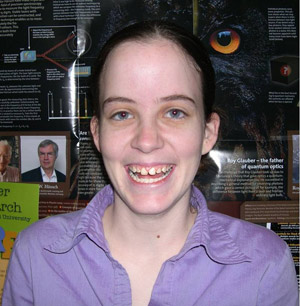 Within the chilly depths of interstellar space are large clouds made of gas and cold dust particles that are coated with simple ices like water (H2O), carbon monoxide (CO), and methane (CH4). These clouds are the nurseries for the next generation of stars in our galaxy. The particles of gas and dust are the building blocks of stars, planets, and ultimately life and by studying them, we may begin to tell the story of our own origins. Undergraduate student Melissa Pastorius and her advisor, Dr. Erika Gibb, are using spectroscopy to study the composition of the ice and gas in these regions, concentrating primarily on objects called T Tauri stars. Within the chilly depths of interstellar space are large clouds made of gas and cold dust particles that are coated with simple ices like water (H2O), carbon monoxide (CO), and methane (CH4). These clouds are the nurseries for the next generation of stars in our galaxy. The particles of gas and dust are the building blocks of stars, planets, and ultimately life and by studying them, we may begin to tell the story of our own origins. Undergraduate student Melissa Pastorius and her advisor, Dr. Erika Gibb, are using spectroscopy to study the composition of the ice and gas in these regions, concentrating primarily on objects called T Tauri stars.
T Tauri stars are low mass young stars surrounded by disks of gas and dust that may be undergoing planet formation. It is thought that the Sun went through a similar phase early in its evolution. Hence, studying the chemistry in these regions may give us information about the early chemical evolution of the solar system. In particular, the simple ices that coat dust grains undergo chemical and physical changes when heated or radiated by starlight during the star formation process. To study these processes, we have collected data for many different young stars in different environments and evolutionary states.
Melissa’s data uses the SpeX infrared spectrometer on the Infrared Telescope Facility, a 3-meter telescope located on Mauna Kea, Hawaii, to produce a spectrum covering the wavelength range from 2 to 5 mm for each T Tauri star. The spectra are analyzed by identifying spectral signatures of ice coatings on dust grains. These signatures are extracted from the spectra and compared to a database of laboratory ice spectra to determine the physical characteristics. From this, Melissa can determine the temperature of the ice toward these young stars and can infer whether the ices are pure or mixed with other molecules. The best fit laboratory spectra indicate that the ice towards these regions of low mass star formation is dominated by cold material separated into a polar layer (mixed with water) and an apolar layer (mixed with a molecule like CO). Interestingly, there are some remarkable similarities in composition of ices toward young stars. There are also some intriguing differences, like large variations in CO and methanol (CH3OH). The reasons for these differences is still being investigated.
In the future, Melissa plans to incorporate Spitzer Space Telescope data for her sources to study additional ice components, particularly substances that cannot be observed from Earth’s surface, such as carbon dioxide (CO2). Also, additional data will be collected on an upcoming observing run at the Infrared Telescope Facility. The data will be used to investigate ices in different star formation regions to address how ice chemistry is affected by the conditions in different clouds. In particular, she will investigate the affect massive young stars have on the chemistry of their lower mass neighbors and how chemistry progresses in regions where only low mass stars are forming. It is hoped that these observations will lead to a better understanding of the chemistry that occurs throughout the formation of a star and planetary system and how our early solar system evolved.
|







